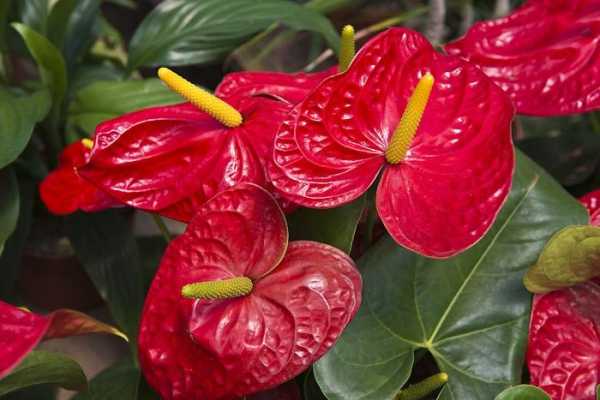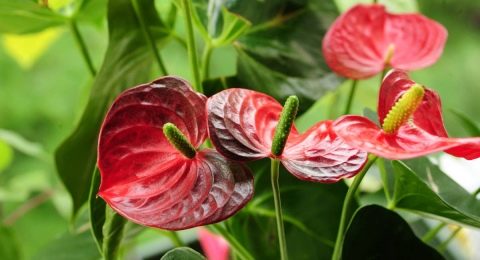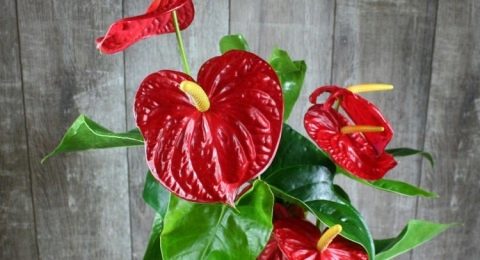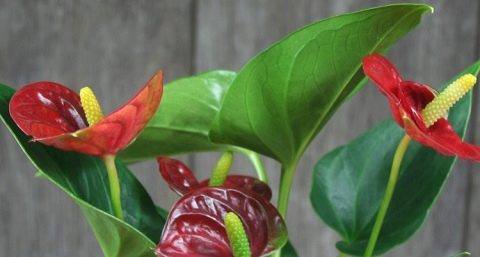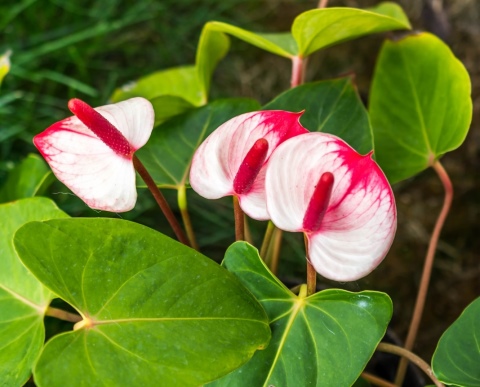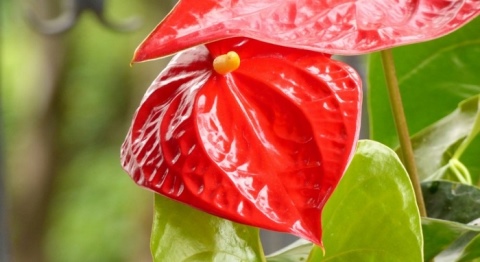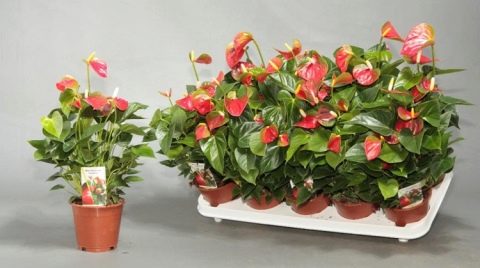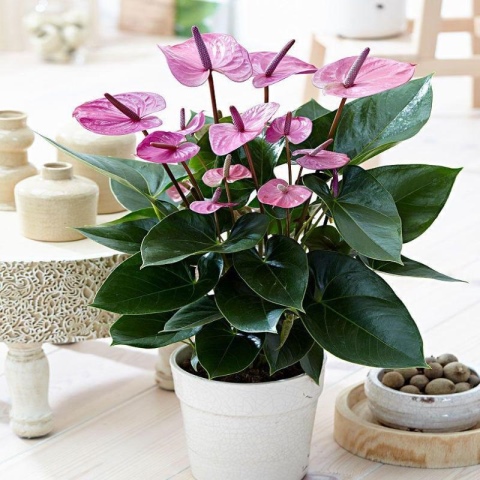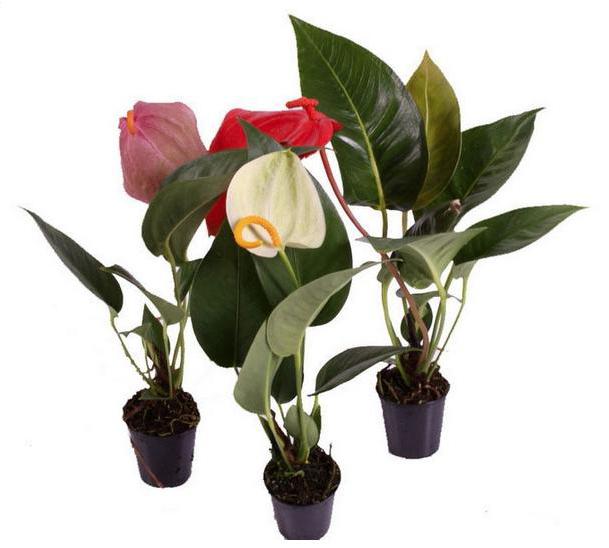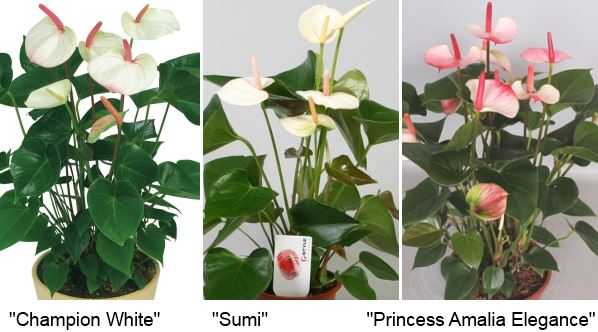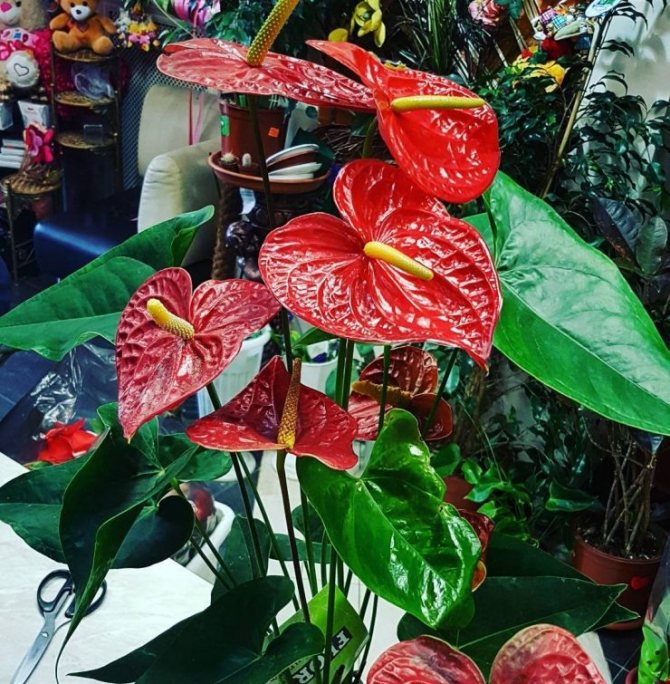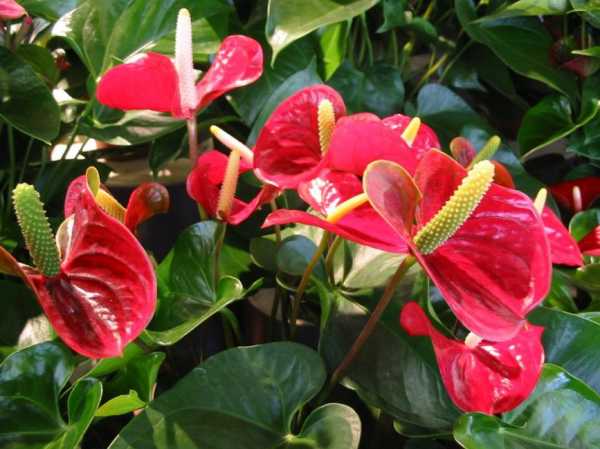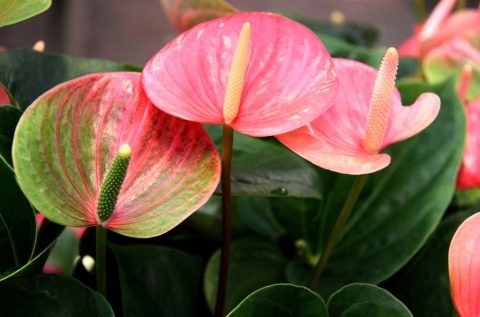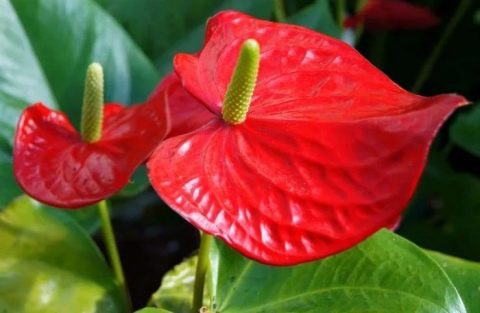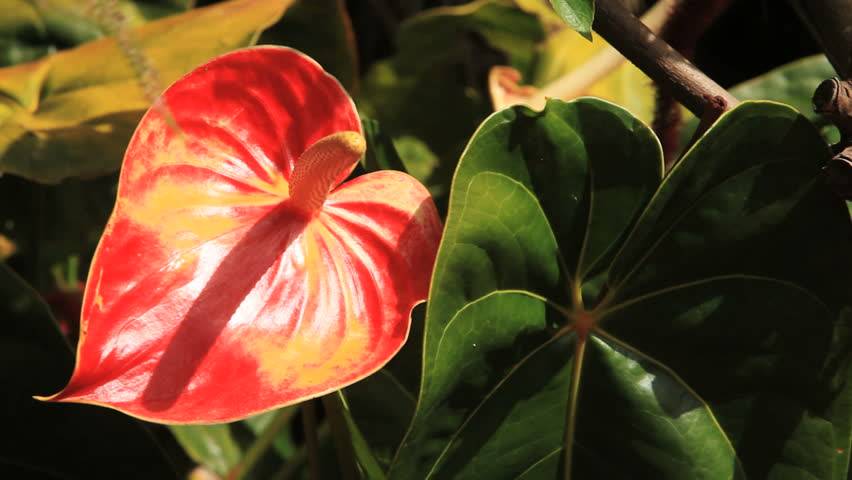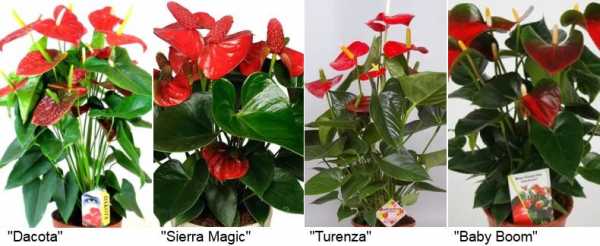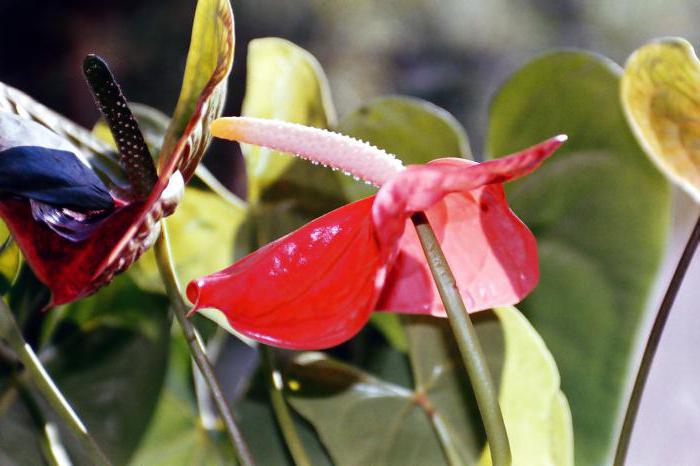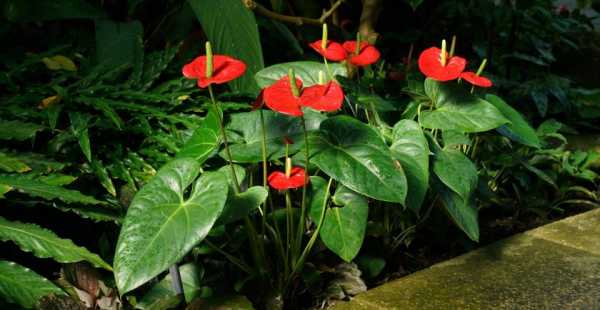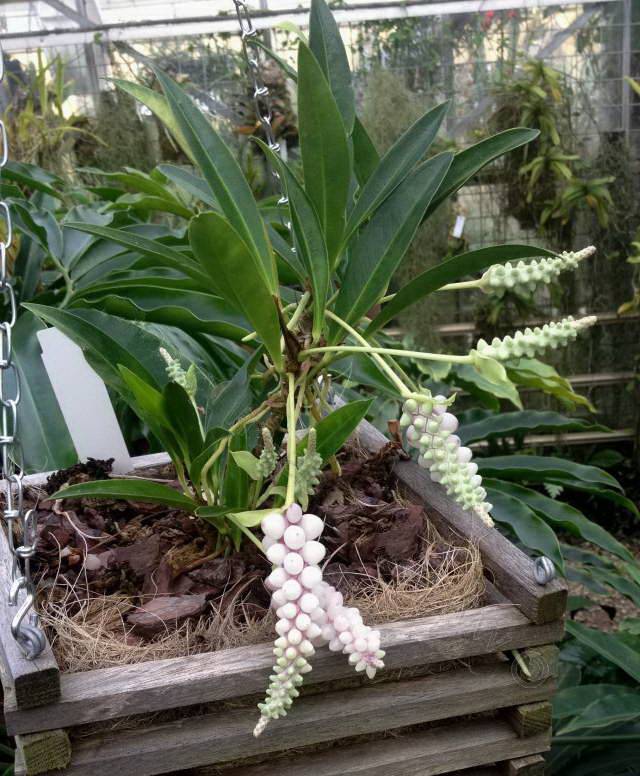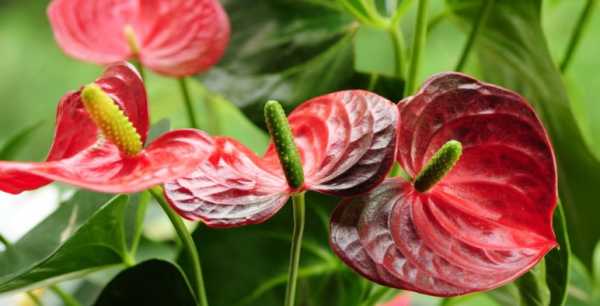Anthurium Andre care at home

Anthurium Andre feels great at home, but only under certain conditions of detention.
Location and lighting
Anthurium flower Andre does not like direct sunlight. It is recommended to place it on windowsills from the east, north-east, west and north-west sides of the house. The light should be diffused, and the place may be partial shade. In the period from October to February, when there is not enough natural light, you can supplement the illumination of plants with fluorescent lamps or phytolamps.
Temperature
The favorable temperature for growing Andre anthurium in the summer is from 20 to 25 degrees Celsius. Growth can slow down or stop if the temperature drops to 18 degrees. In winter, for 1.5-2 months, anthurium is in a dormant period and prefers to be kept in cool conditions with a temperature of 15-16 degrees. These cool conditions are conducive to bud formation and active flowering in the future.
Watering
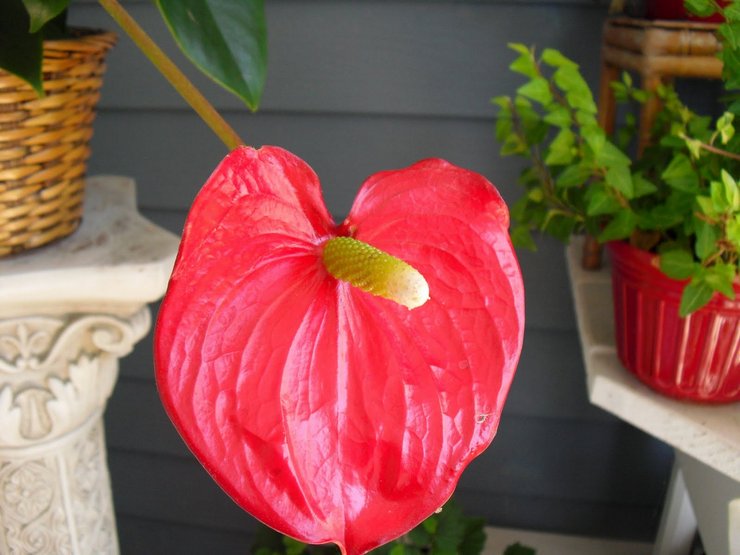
Irrigation water for anthurium should be filtered or boiled, you can use tap water, but before watering it is recommended to add a small amount of lemon juice or a few drops of acetic acid to it. Soft, settled water with a temperature of 20-22 degrees is plentifully watered crops throughout the growing season. The next moistening of the soil is carried out only after a slight drying of the upper layer, but no more than 1-2 cm. In winter, the volume and frequency of watering are reduced. Lack and excess of moisture in the soil is equally dangerous for the life of anthurium.
Air humidity
A high level of humidity is necessary for Andre's anthurium throughout the year (even during the dormant period). To maintain it, it is recommended to carry out daily water procedures in the morning and evening hours in the form of spraying with warm water. An additional vessel with water, located next to indoor flowers, or a tray with wet expanded clay also contributes to increased humidity.
The soil
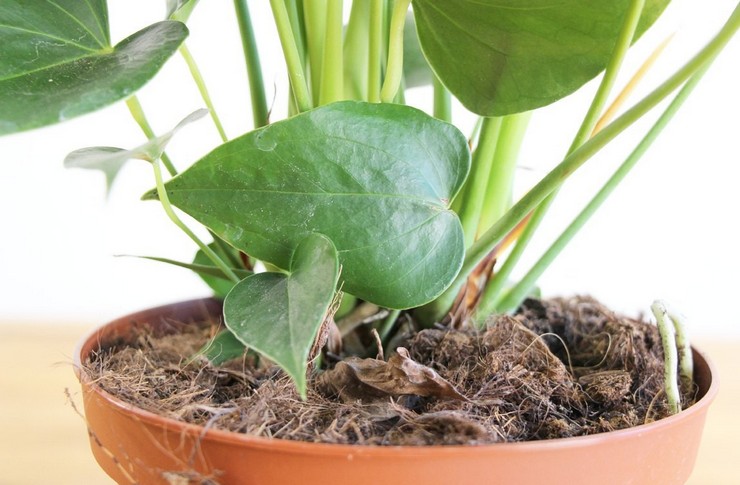
The potting mix must be breathable. This requirement is met by the soil for growing orchids, which can be purchased at a specialized store. When preparing the mixture yourself, it is imperative to take one part of vermiculite and coarse river sand, two parts of crushed pine bark, coniferous, peat and leaf land and a small amount of charcoal.
The flower container should be shallow, but with an obligatory drainage layer (at least 3 cm) and additional holes on the walls.
Transfer
In the first 5 years, the Andre anthurium plant is recommended to be transplanted once a year, and in subsequent years - as needed.
Reproduction of anthurium Andre
Anthurium Andre propagates in several ways: by apical cuttings (in the presence of aerial roots), by seeds, by dividing an adult bush into young divisions, by lateral offshoots.
Diseases and pests
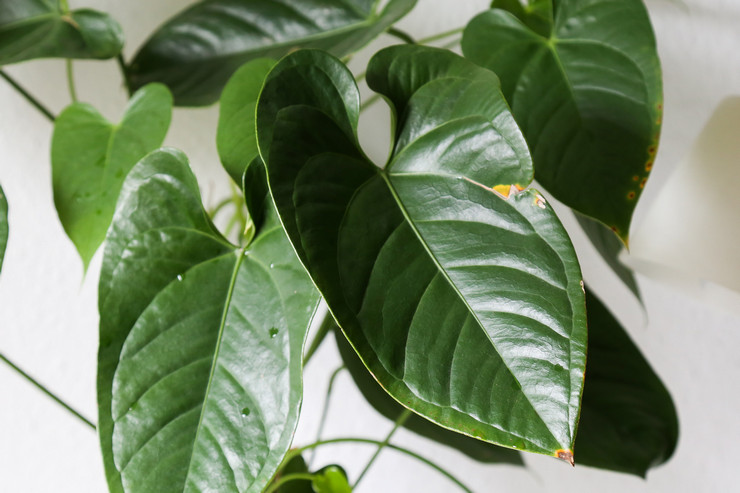
The main pests of anthurium are scale insects and spider mites. Dealing with them is not easy and ineffective. A regular warm shower is an excellent means of preventing harmful insects.
The flower is often sick due to improper care or under improper maintenance conditions. The main diseases are stem rot, root rot, rust, anthracnose, downy mildew.
The most common causes of root and stem rot are low indoor temperatures and regular waterlogging of the soil.
Signs of anthracnose are dry brown tips on the leaves, which lead first to the complete drying of the leaf part, and then to the death of the entire culture.It is very difficult to cure a plant from this ailment, and sometimes it is simply impossible. As a preventive measure, experienced florists recommend regularly spraying with fungicides.
Withering of anthurium often occurs due to contact with an infected indoor flower or poor-quality substrate, as well as with a lack or excess of fertilizers.
Anthurium Andre Dakota. Care and watering

Houseplants Flowering Houseplants
Red anthurium - a flower from an old legend
A bright glossy blanket and a yellow ear of many tiny flowers. This is how the classic anthurium looks like, the legend of the origin of which has been remembered for many centuries in South America.
On this topic:
BACK
FORWARD
1 of 8
The young beauty sacrificed her own life in the name of love and fidelity. Struck by such selflessness, the gods turned the unfortunate woman into a scarlet flower with a single petal in the shape of a girl's heart.
Red anthuriums are still considered classics today and are highly valued among flower growers.
Anthurium Dakota can rightfully be called the most famous and widespread variety. At the same time, the plant stands out not only for the rich color of the bedspread, but also for its size from 14 to 23 cm. A large, spectacular plant cannot be overlooked even in a very spacious room.
Anthurium's name comes from Anthos - flower and Oura - tail. But no less than the tail, the ear is like the long neck of a flamingo. But unlike flamingos, anthurium today can have more than just red or pink colors.
Anthurium inflorescences of the Minnesota variety stand out from a number of equally spectacular plants with bright scarlet bracts and cobs, changing their white color first to yellow, and then to green.
The group of Red anthuriums with a prevailing red veil in color is very large and diverse. Anthurium Edison also belongs to it, presented on store shelves not only with plants with red inflorescences, but also varieties blooming in pink tones.
In addition to scarlet and classic red varieties, you can also find Dark Red Anthurium. Bracts of such anthuriums, as in the photo, come in all shades from raspberry, wine to burgundy, brown or almost black.
An example of brown anthurium is the Otazu Brown variety with a deep burgundy heart-shaped bedspread and a straight light green ear.
Anthurium varieties Utah willingly form large solemn inflorescences with a glossy textured blanket up to 14 cm in diameter. Anthurium cobs and bracts are violet or deep purple. At the same time, older inflorescences can be easily identified by the green tint at the base of the bedspread.
The luxurious Black Queen Anthurium appears even darker thanks to the light coloration of the cob. On the surface of the dense glossy bracts, all the veins stand out in relief, giving the inflorescence a fantastic look.
Anthurium Turenza - description
This type of aroid is also called Andre anthurium. It belongs to evergreen perennials. Leaves are dense, glossy, slightly wrinkled, dark green, in the shape of a wide lancet. The leaves can be up to thirty centimeters long. The flowers are large, flat, oval, with rounded edges, like a heart, inside contain long yellow inflorescences, in appearance resembling corn cobs. Anthurium Andre is distinguished by its bright color during flowering: red-crimson flowers will always create an atmosphere of celebration and comfort, and when the plant fades, you can observe the appearance of round orange fruits on it.
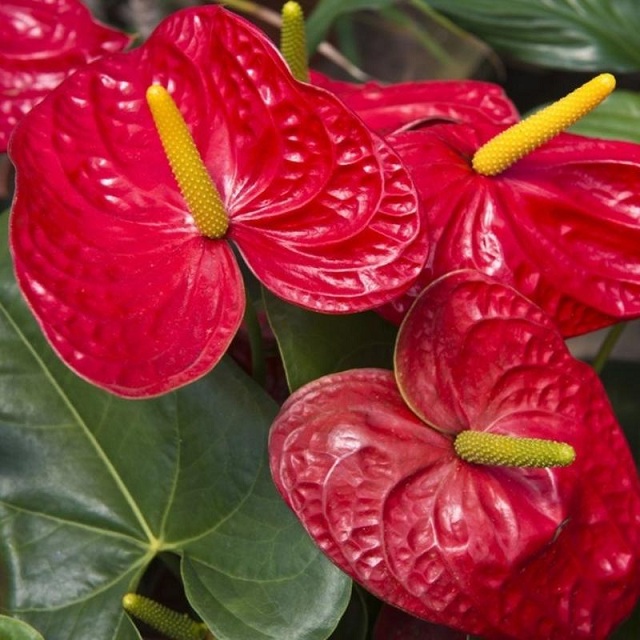
Like all representatives of the aroids, the Turense anthurium has an aerial root system: this means that its roots can exist both in the ground and in the open air. Its characteristic feature is the "throwing" of parts of the root system outward, since in nature this plant is an epiphyte - it clings with the help of roots to other taller and larger trees and flowers.
Pests and diseases
Among all types of pests, anthurium is most often attacked by ticks and scale insects.If suddenly dry parts appear on the plant, and this is not justified by insufficient watering and spraying, then you should take a closer look at the bush. Since these parasites are able to suck out cell sap, the anthurium will soon begin to fade and dry out.
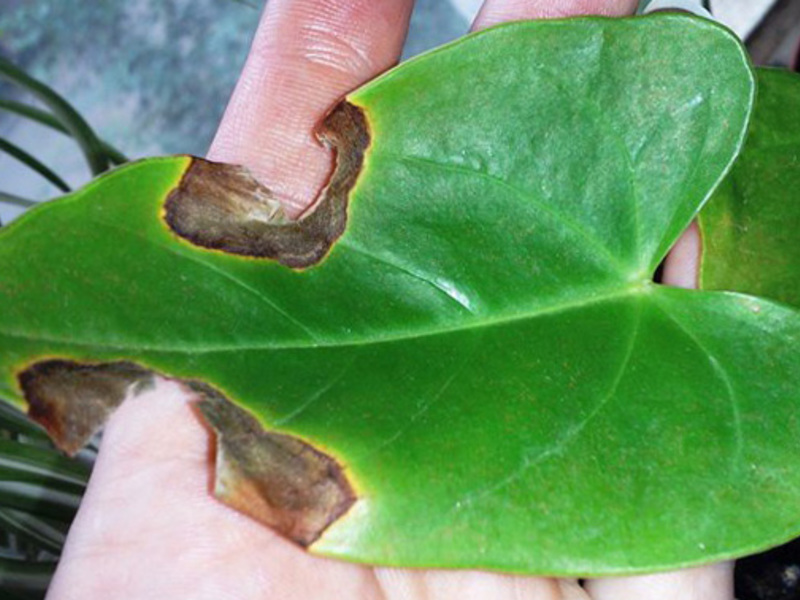
Pests
If the scabbard or tick is already wound up, then it is necessary to treat it with Actellik. But it is better if preventive measures are used, for example:
- Regular rinsing under a warm shower.
- Treatment of sheet surfaces with a soap solution.
Note! It is better to carry out preventive measures than to get rid of parasites later. After all, it is quite difficult to bring them out
Considering all the described features of the growth of anthurium, it will be quite easy to breed it at home. You just need to regularly look after the flower and follow all the recommendations. The mix composition, which combines several varieties of anthurium of different colors, also looks beautiful.
vote
Article Rating
Breeding features for this species
This culture is propagated by vegetative and seed methods. The seed method is not suitable for home propagation of a flower. Since pollination is necessary.
Auturium reproduces in several ways.
- Division by layering - the climbing stem is pinned to the ground at a distance of 10-15 cm from the mother plant and periodically moistened. After that, the sprout is cut off and planted without touching the root system.
- Propagation by cuttings - it is necessary to cut off the top of the flower about 8 cm. If there are leaves, then it is better to remove them. The cut should dry in the air, and the cut stalk is placed in water and covered with a bag (a kind of greenhouse). After the roots appear, the plant is transplanted into the ground.
Anthurium Princess Amalia Elegance


Number of Blocks: 49 | Total number of characters: 43376
Number of donors used: 6
Information for each donor:
Artificial Hybrid Plant
It belongs to medium-sized varieties, the height of an adult bush is 45-50 cm. The leaf plate is leathery, dense, dark green in color. The general shape of the leaf is cordate, the tip is pointed, the edges are noticeably curved, even a young leaf has a curved shape. The petiole is dense, strong, the knee (geniculum) is thickened, the bend is poorly expressed.

The size of the leaf plate is 15-17 cm, in an adult plant it reaches up to 20 cm.
Karma Purple is a one-color variety, the main color is purple, purple. But, like all anthuriums, Karma Purple changes the color of the bracts in each phase of its flowering.

At the very beginning, when the flower has not yet fully opened, it has a very dark purple color.
The young flower retains this color, but it becomes more saturated, gloss appears. The ear is also purple in color, but of a darker shade. The cob is erect, 5-6 cm in size, compared to the size of the bracts, which is 7.5-9 cm, it looks rather long. The edges of the flower are strongly curved, which gives the flowering plant a fantastic, fabulous look.

As they grow older, the color of the bracts changes, becoming first dark pink, then pale pink, "green ears" appear, the cob turns green. The bract is almost completely smoothed, the bend disappears.

The variety Karma purple is unpretentious, the period of abundant flowering is 8-9 weeks, under good conditions and proper nutrition it can bloom all year round. Differs in abundant flowering, the plant can produce 8-12 flowers at a time.
Suitable for growing, both as a home plant and as a decoration for office spaces.
Location and care
Anthurium is a tropical plant, therefore it prefers abundant lighting, in the range of 5000-8000 lux, but without direct sunlight. The eastern and northeastern windows are suitable for it, on the western, southwestern and southeastern windows, in the summer from 12 to 17 hours, in order to avoid sunburn, the plant must be shaded.
It is thermophilic, in summer, a temperature of 22-26 C is required, in the winter period of time not lower than 16 C. At a temperature of 16-18 C, the laying of flower buds stops, anthurium stops blooming.
Watering and feeding
Anthuriums are very sensitive to hard water, when used, their growth slows down, flowering stops. When watering, it is recommended to use melt, rain, distilled water or water from a reverse osmosis filter. Anthurium should be fed with a full range of macro and micronutrient fertilizers. In the winter period, in the absence of additional lighting, 1 feeding is enough, once a month.
Andre and other species
- A. André (A. andraeanum). The plant is terrestrial or epiphytic, native to Colombia. A flower with a short stem. The leaf blades, the size of which is 25-30 cm in length and 10-12 cm in width, have an oval-lanceolate shape with a heart-shaped base. They hang down on long stalks. The bedspread, painted in pink, salmon or white, also has a heart-shaped shape and a slightly wrinkled glossy surface.
- A. crystal (A. crystallinum). This species is appreciated by lovers of indoor floriculture primarily for its beautiful foliage with an unusual color. Crystal anthurium leaves have a wide-heart-shaped shape and reach 60 cm in length and 40 cm in width. The leaf blades are olive green and decorated with whitish green veins, for which the species got its name. The inflorescence and veil are inconspicuous, but the flowers exude a pleasant clove scent.
- A. Sherzer (A. scherzerianum). The leaves are elongated-lanceolate. They grow in length from 15 to 30 cm, and in width 6–10 cm. The coverlet is very bright, it is painted in yellow, pink, scarlet-red or white tone, sometimes with spots. The cob inflorescence is twisted in a spiral, for which the people called the plant "pig's tail".
- A. Armenian (A. armeniense). Epiphytic plant. The leaves are narrow-ovate, pointed at the apex. They are dissected at the base. The inflorescence is erect, and the veil, which has an elliptical shape, is painted in a white tone. The ear becomes purple in color during the flowering period.
- A. Bakeri. Baker's anthurium bedspread is green and slightly bent back. Lanceolate leaves reach 60 cm in length and 6 cm in width. The plant is especially decorative during the fruiting period, thanks to its bright red berries.
- A. beautiful (A. bellum). Unlike other species, adult specimens of beautiful anthurium have caudex (thickened trunk in which moisture accumulates). The leaves are dark green with white dots and a snow-white midrib.
- A. thick-veined (A. crassinervium). The species is impressive in size, the plant reaches 1.5 m in height and 1.2 m in width. Large ellipsoidal leaf blades narrow at both ends and have a dark green color. Leaves are dense and wavy at the edge.
- A. finger (A. digitatum). The leaf blades of this species of anthurium are dissected, they are colored dark green and covered with small white specks. It looks especially decorative during the fruiting period, when the ears are covered with small purple-black berries.
- A. excellent (A. magnificum). Leathery olive-green leaves with light veins grow rather large (up to 60 cm in length and up to 50 cm in width). The bedspread is painted in a dirty red, lilac or greenish tone.
Description of varieties for growing at home
Breeders are constantly working on the creation of new spectacular varieties of anthurium with different colors of the bedspread. Most often in flower shops you can find Andre and Scherzer's anthurium, among the varieties of which deserve special attention:
- Anthurium Andre Winner (Champion) is a plant with an elegant red or white veil.
- Anthurium Fantasy Love is a flower with a very beautiful veil, painted in white, pink and green.
- A two-color red-green bedspread at the Baby Boomer anthurium.
- The Prince of Orange variety has a pretty bright orange shade.
- A charming bedspread, the base of which has a green tint, and the edges are painted white, at Anthurium Romance.
- Scherzer Lindsay's anthurium attracts with gracefully curved cob flowers and a spectacular bright red bedspread.
- The Black Queen variety has an unusual dark-burgundy, almost black blanket, which makes the flower looks gorgeous and very exotic.
How to care for a houseplant at home?
Watering
In summer, abundant watering is required in small doses 2 - 3 times a week. The soil should be slightly damp in the spring and summer.
Important! Complete drying of the substrate is unacceptable.
In the fall, the watering schedule changes. It is enough to moisten the soil once every 7 to 10 days. Irrigation water should be warm, up to 30 ° C. Add a few drops of lemon juice and vinegar to the water. Immediately after watering, excess water should be drained; wetting of the roots provokes the appearance of rot.
In the heat, to increase the humidity of the air, spraying the leaves should be added. Place open containers of water next to the flowerpots. Also, to increase moisture, the soil in the pot is mulched with moist moss. The optimum air humidity is 80 - 90%.
Light
Lighting should be bright, but somewhat distant, diffused. From direct sunlight, burns appear on large leaves - brown spots.
It is advisable to choose the western and eastern parts of the house. From the scorching sun, the windows are shaded with white paper or a light curtain. The northern arrangement of colors requires additional illumination with special lamps.
Due to the lack of light, the plant does not form flower buds.
Priming
Ordinary garden soil is not suitable for a tropical flower. The mixture should be nutritious, acidified, friable, well-permeable. For planting, you can use a ready-made orchid mixture.
The composition of the potting soil:
- Humus - 2 tsp
- Leafy ground (unsifted) - 1 tsp
- Peat - 1 tsp
- Sand - 1 tsp
- Drainage.
Drainage layer - broken brick, pieces of charcoal, moss - sphagnum.
Important! a little vermiculite and small pieces of pine bark can be added to the soil for breathability.
Pruning
Pruning is necessary for an adult flower to rejuvenate the bush. The procedure is carried out in early spring during transplantation.
Trimming scheme:
- Side stems are cut out together with roots for further propagation.
- The tops of the shoots, together with aerial roots, are cut for propagation.
- For long-term flowering, wilted buds are cut off.
The central trunk is not trimmed with roots.
After pruning, watering should be halved until new lateral rosettes of leaves are formed.
We offer you to watch a video about the rejuvenation of the Andre Anthurium bush:
Top dressing
Fertilize the plant in spring and summer once every 10-14 days. In early spring, you should feed the flowers with urea or ammonium nitrate. Nitrogen fertilizers promote the growth of leaves and stems.
During the formation of buds and the entire flowering period, complex mineral fertilizers should be used, which include trace elements of zinc, potassium, magnesium, iron. It is recommended to use ready-made fertilizers for flowering plants and orchids.
Attention! For the formation of inflorescences, it is necessary to make top dressing all year round, strictly observing the regime and doses of fertilizers.
Pot
The transplant capacity is selected in accordance with the size of the root. Anthurium Andre does not bloom in too large containers. The pot should be compact, not too deep.
Be sure to make drainage holes at the bottom of the pot for air access and water outflow after watering.
Transfer
Young flowers require annual replanting. Adult bushes are planted once every 2 - 3 years for rejuvenation. The transplant is carried out in the spring.
Transplant scheme:
- The top mulch layer is removed from the pot.
- The entire bush is carefully removed.
- Damaged roots and dry stems are cut.
- Using the transshipment method, the bush is placed in a new pot with a drainage layer of up to 2 cm.
- The root is sprinkled with a new substrate.
- The earthen ball is slightly compacted.
- From above, the surface is mulched with moss and peat.
Wintering
During the winter months, Andre's anthurium enters a state of dormancy. In winter, the pots are moved to a cool place, the air temperature is 15-16 ° C.
Important! The plant reacts poorly to sudden daily changes in air, drafts and a drop in temperature to 10 ° C.
The soil is moistened carefully, the main thing is to prevent the earthen coma from drying out. Do not spray the leaves in winter, dust on the leaves is removed with a damp cloth once a week
During this period, it is necessary to feed the flowers with potassium and sodium humate 1 time in 2 - 3 weeks through watering.
We suggest watching a video about home care for this plant:
Our readers are encouraged to familiarize themselves with information about other varieties of anthurium. Read about these varieties: Princess Amalia Elegance, Cavalli, Dakota, Hooker, Scherzer, Utah, as well as crystal, orange and climbing anthuriums.
What does the anthurium Andre look like
Anthurium belongs to the Aroid family, which includes mainly vines, evergreens and epiphytes, which do not need soil to grow fully. Homeland are the tropical zones of Central and South America.

Anthurium Andre
If we talk directly about the features of the plant itself and the Anthurium Andre variety in particular, the following points should be noted:
- The flower is a cylindrical stem, covered with small villi. But it is the bract that makes a vivid impression - it is a fleshy heart-shaped petal with a color ranging from white to black-purple.
- The flowering of the plant occurs throughout the year, this is especially pronounced when suitable conditions are created. Each peduncle retains its original appearance from 1 to 2 months, depending on the variety.
- With full pollination in place of the flower, berries are formed, including seeds.
- The leaf plates are quite massive - they reach 30 cm in length. The color is most often deep green, having a glossy gloss.
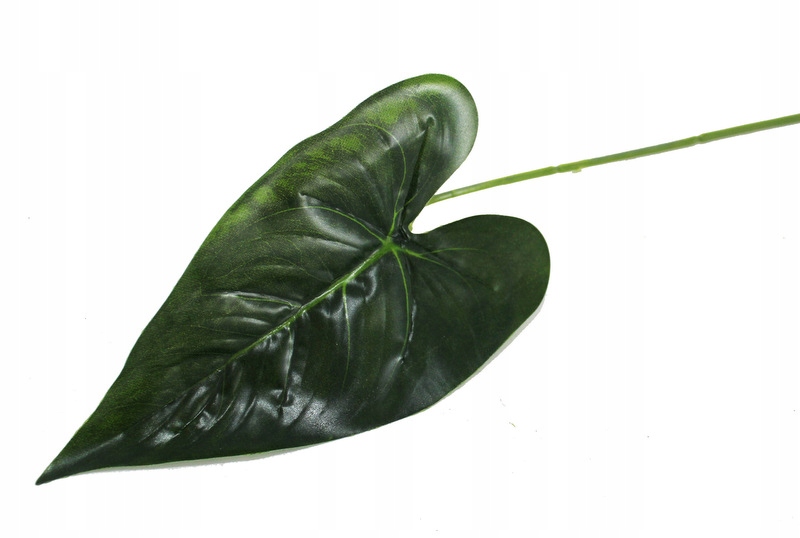
Plant foliage
Common varieties
This home flower has thousands of varieties, but not all are grown at home. Most often used as interior decoration:
- Leganza cultivar - a distinctive feature is that the color of the petal varies during flowering from a pale pink to a rich orange hue.
- Otazu - has dark red, almost burgundy bracts. They look quite contrasting against the background of a yellow flower.
- Silens is an interesting bicolor option. The flower has a yellow-red, uneven color. And the bracts are white or creamy with rich pink-beetroot veins.
- The largest hybrid is Favorit. It features dark foliage and a bright pink bedspread.
- Scherzer is an original variety in which the flower cob is not straight, but winding. And the bedspread is lanceolate and matte.

Mix
Note! In addition, there are varieties, the stipules of which can be colored blue, purple, bright yellow, black, green. Anthurium Andrianum stands out among the dark red varieties.
Anthurium Andrianum stands out among the dark red varieties.

